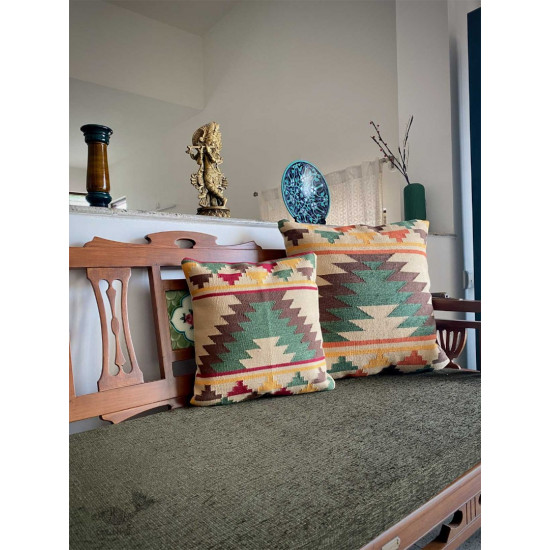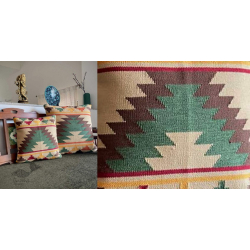- Availability: 5
- Made & Mkt by: Kalavilasa
- Product Code: 2032-CK23-KV-CC314-1-12
- Weight: 1,000.00g
- Dimensions: 30.00cm x 30.00cm x 25.00cm
Available Options
The typical dispatch time is 2-3 days; however, in special cases, it may take longer. Please refer to the product details section for specific timelines. Once dispatched, we will share the tracking details with you.
For returns, you can file a request within 24 hours of receiving the product. If the package is damaged, please make a video while unboxing and share images of the damaged item along with your return request.
Dating Dhurries Back In Time
Flat-weave rugs are called dhurries in India. They have been woven for centuries, perhaps more than a millenium. Dhurrie was primarily a utilitarian textile, being used for purposes such as covering a wooden bed, or seating people on a bare floor, or as a prayer mat. The design of the dhurrie was simple, and typically featured stripes. It was always made of cotton, and was woven in households.
In the 16th century, Mughal kings brought carpet and it's weavers from Persia to India. Unlike a dhurrie, it was a decorative textile which had a pile, and was made of wool and silk. The design of a carpet influenced the dhurrie design, which the Indian artisans readily adopted and internalized. Indian motifs like lotus and peacock were added to the design portfolio. To cater to demands from Europe, pictorial and floral designs were woven in the dhurrie. During colonial rule in India, the British found a novel use of dhurrie by getting the prisoners to weave dhurries in Indian jails. To this day, the best vintage dhurries are the ones made in a jail.
The Rajasthan Maharajas were enamored by the Persian kilims, a flat-weave rug admired for its geometrical patterns and earthy hues . Made of wool, these kilims were unsuitable for the hot weather in Rajasthan. The local artisans were asked to make decorative cotton dhurries, a first in India. Unlike kilims, the Rajasthan cotton dhurries were made in bright colours, and used local motifs.
Natural traders, the British encouraged Indian artisans to make wool dhurries, primarily for export to the UK. After independence, the patronage of Maharajas diminished in Rajasthan and the British owners of wool dhurrie workshops left India. Since then, dhurries have made a comeback as a chic rug in the world of home textiles.
| Craftsmen | |
| Made by | Artisan working with Kalavilasa |
| Village | Hatwa Village |
| Returns and Exchange | |
| Note | ♦ The items in this category are non refundable. ♦ The products in this category is handmade. ♦ Only defective pieces will be taken back if notified within 1 day of receiving the parcel. |
| Shipping ~ | |
| Shipping | Medium Size - 16" x 16" inch Large Size - 20" x 20" inch |
| Material | |
| Made of | 100% pure Indian cotton |
| Instruction | |
| Note | The products in this category is handmade. These might slightly differ from as seen on digital screen. |
| Care | Hand wash or machine wash the cushion cover using a mild detergent and cold water. Do not spin dry in the washing machine. |
| Restrictions | |
| COD - Option | Not Available |

















-225x150w.jpg)
-225x150w.jpg)
-225x150w.jpg)
-225x150w.jpg)
-225x150w.jpg)
-225x150w.jpg)
-225x150w.jpg)
-225x150w.jpg)
-225x150w.jpg)
-225x150w.jpg)
-225x150w.jpg)
-225x150w.jpg)
-225x150w.jpg)
-225x150w.jpg)



-225x150w.jpg)

-225x150w.jpg)

-225x150w.jpg)















-225x150w.jpg)

-225x150w.jpg)

-225x150w.jpg)

